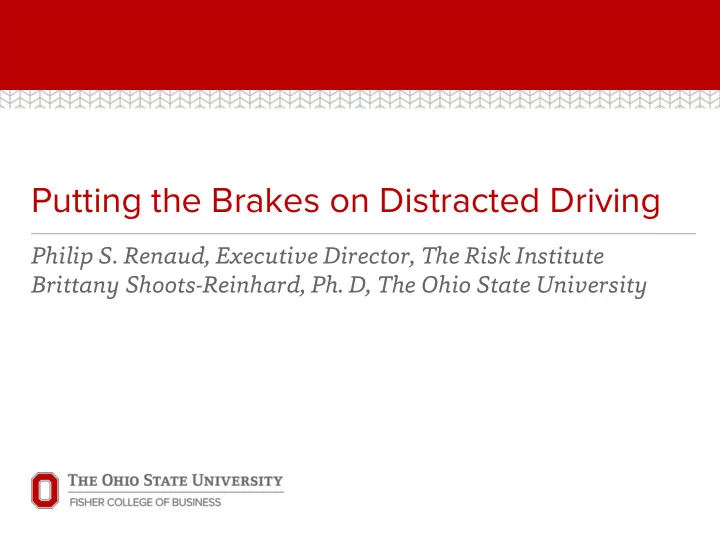

Putting the Brakes on Distracted Driving Philip S. Renaud, Executive Director, The Risk Institute Brittany Shoots-Reinhard, Ph. D, The Ohio State University
The Risk Institute Approach The solution to end distracted driving won’t happen in courtrooms or laboratories. That’s why the Risk Institute takes a four-tiered, cross- disciplinary approach. Research. Urban Planning. Legislation. Technology.
Today, we want to take a deeper dive into some of our most recent research examining driver behaviors and motivations
Prevalence of Driver Distraction How likely are you to use your phone for any reason while driving a car while the car is in motion? Reality* Goal 10.4 33.5 100.0 25.9 never <10% of trips <50% of trips 29.5 50% or more trips
Why do people drive distracted? • Underestimation of distracted driving : people just don’t see it as risky • Overconfidence in driving ability : people think risks apply to others, not them • Affective reactions : see phones as beneficial; downplay risk • Motivated denial : people don’t want to see risk; rationalize behavior • Perceived norms : think others do it and/or it’s not a big deal
Why do people drive distracted? • Most common response was to never drive distracted • People that drive distracted… • Think many other people drive distracted • Are overconfident in their DD ability • Think distracted driving is NOT risky • See more benefits to using phone and driving • Are attached to their phones • Are high in reactance to attempts to change them (only measured in Survey 2—predicts DD more than risk or gender) • Are male (Survey 1 only) or younger (Survey 2 only) • Have higher verbal intelligence
What existing methods to reduce DD does the public like ? Support teen educ programs teen coach (DRVN) ins discounts fines org pledges Survey 1 bluetooth Survey 2 app-respond 1 2 3 4 5 6
What existing methods to reduce DD does the public dislike ? Support read only apps eye tracking coaching apps (Mentor) org bans Survey 1 Survey 2 steering wheel sensors car pull over law bans* 1 2 3 4 5 6
So, how can we increase support for reducing DD? One easy option: same policy, different language (i.e., framing) Support apps that help you not use apps that prevent cell use charging good drivers less charging bad drivers more laws fining use *law banning cell use 1.0 2.0 3.0 4.0 5.0 6.0
Next Steps Reduce message resistance • We recently developed a measure of message resistance or reaction that is related to • Driving distracted and greater perceived ability to do so • Lower risk perceptions and greater benefit perceptions of DD • Being young and male • Lower attitudes towards reducing distraction and less message acceptance Develop and test more effective messaging • Less is more; keep it simple • Evoke emotion • Present numeric risk information and visual aids
Recommend
More recommend